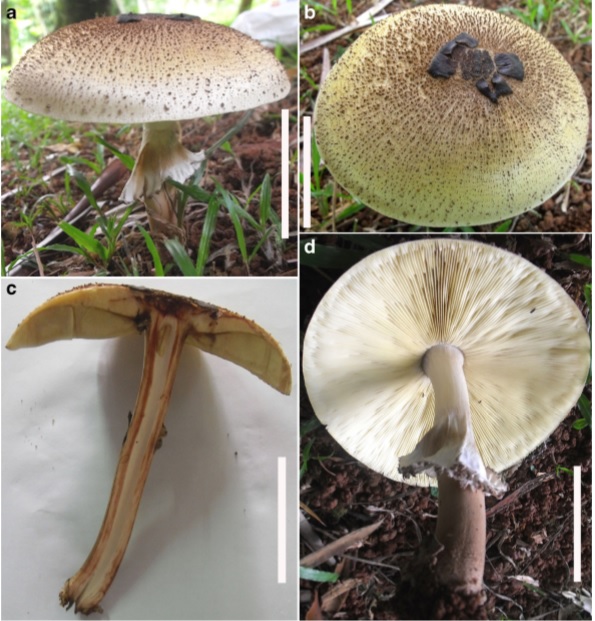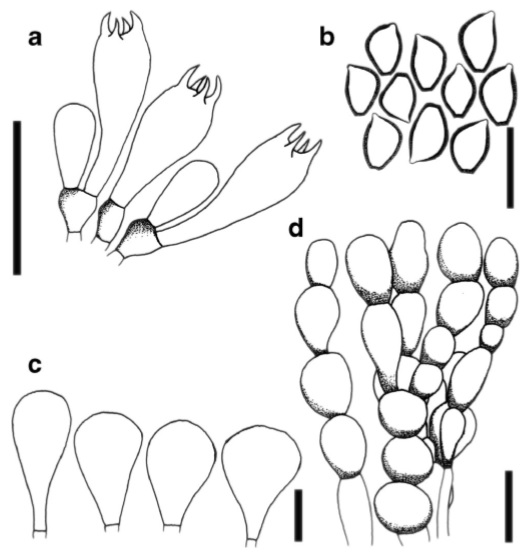Clarkeinda trachodes (Berk.) Singer
Facesoffungi number: FoF 01844
Description: Basidiomes medium to large, fleshy. Pileus 120 mm in diam., hemisphaerical when young, and becoming convex to applanate at maturity; pellicle on the cap brown to coffee or chocolate brown, thin when young and thick when mature, and brown to grayish brown at maturity; the whole surface except the pellicle area covered with grayish brown to vinaceous brown squamules, with numerous, small, loosely floccose, brown squamules; context up to 8–9 mm thick in the center of the pileus, white, instantly turning reddish with exposure. Lamellae free and distant from the stipe, white to dirty white when young, turning to olive brown when mature, becoming reddish brown after bruised, crowded with lamellulae, entire margin, concolorous. Stipe 140×45 mm, central, subcylindrical, fistulose in mature specimens; surface dirty white to white at the apex, light brown to brown towards the base, glabrous above the annulus, lower half densely covered with minute, brown, furfuraceous squamules. Annulus present on the upper part of the stipe but not the top, up to 20 mm, thick, membranous and remaining up to maturity, adaxial part glabrous with fine longitudinal striate but abaxial part rough with squamules. Volva presents, grayish, dirty white to white, membranous, usually closely appressed to stipe and eventually inconspicuous. Basidiospore deposit not obtained. Basidia 17–28×5.5–9 μm, mostly clavate to sub clavate, thin-walled, tetrasporic, but seldom 1-, 2- or 3-spored, bearing four short sterigmata, hyaline, smooth, lacking incrustations, clamp connections absent. Basidioles narrowly clavate to clavate. Hymenophoral trama interwoven, hyphae cylindrical to slightly inflated, up to 14μm wide, thin-walled, hyaline, and without clamp connections. Basidiospores (5 –)5.5–6( –7)×(3.5–)3.9–4(–4.5) μm, mean Q=1.4 –1.5, ovoid, occasionally broadly ellipsoid to ellipsoid, glabrous, thick-walled, apiculuseccentric, apex or germinating pore prominent and truncate with slightly depressed, olive brown to dark, umber brown in deposit, dextrinoid in Melzer’s solution, not metachromatic in Cresyl blue. Cheilocystidia 25–33×10.5–15.5μm, abundant, scattered to more or less crowded, narrowly clavate, clavate to broadly clavate, obpyriform, hyaline, thin-walled, smooth, lacking incrustations, sometimes with long pedicel and narrow. Pleurocystidia absent. Pileipellis consisting of short branching chains of 4 –7 cells, slightly interwoven, terminal cells 12–23×8–14.5μm, dull brown vacuolar pigment inside the cells in glycerin, water and 5 % KOH solutions, thin-walled, clavate, cylindrical, obpyriform to fusiform or spindle-shaped in rare cases, occasionally branching with lateral cells that are mostly clavate, basal cells nearly subglobose to clavate or cylindrical.
Habit, habitat, distribution: The basidiomes of C. trachodes normally fruit as isolated individuals or in groups of two in disturbed habit at sand at forest edges. Our collection was collected on grassland in Royal Botanic Gardens, Peradeniya, Sri Lanka. It is also known from China, India, Indonesia, Bangladesh and Malaysia.
Material examined: Sri Lanka. Central Province: Peradeniya, Royal Botanic Gardens, 7°15′35.03″N 80°36′ 4.07″E, elev. 590 m, 15 July 2009, Samantha C. Karunarathna (MFLU 10–0139.
Notes: Clarkeinda trachodes is distinguished by its large basidiome size, prominent chocolate or coffee brown to dark brown pellicle on the pileus disc surface, presence of an annulus, olive brown to umber brown spore deposit, slightly thick-walled basidiospores with a truncate apex, and a context that changes from white to reddish brown when exposed. Since Berkeley (1847) first described the species from Sri Lanka, it has been reported from south and Southeast Asia by Petch and Bisby (1950, asChitoniella), Leelavathy et al. (1981), and Pegler (1985, 1986). Yang (1991) has also reported it from the tropical region of Yunnan, China. This is the first report with the molecular phylogenetic confirmation after Berkeley (1847) first described this from Sri Lanka. We therefore designate it as a reference specimen.

Phylogeny of Clarkeinda trachodes and satellite genera in the Agaricaceae based on analysis of ITS sequence data, inferred by maximum likelihood (ML) analysis. Numbers at internodes refer to confidence estimates based on 100 rapid ML bootstraps (only those >50 are indicated). Clarkeinda trachodes from Sri Lanka is highlighted. Leucoagaricus barssii and Leucoagaricus leucothites are outgroup taxa. New sequences is in blue and ex-type and reference specimens are in bold.


